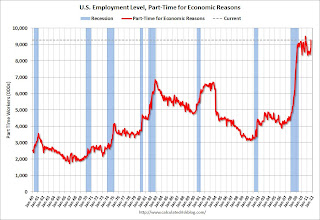by Calculated Risk on 10/07/2011 10:11:00 AM
Friday, October 07, 2011
Employment Summary, Part Time Workers, and Unemployed over 26 Weeks
This was a weak report, but better than many expected. A few points:
• The Verizon labor dispute subtracted 45,000 payroll jobs in August and those jobs were added back in September. From the BLS: "The increase in employment partially reflected the return to payrolls of about 45,000 telecommunications workers who had been on strike in August."
• The household survey showed an increase of 398,000 jobs in September. This increase in the household survey kept the unemployment rate from rising, even as more people participated in the workforce (labor force increase by 423,000). The unemployment rate was unchanged at 9.1%, and the participation rate increased to 64.2% from 64.0%. The employment population ratio also increased to 58.3% from 58.2%.
• Employment for July and August were revised up. From the BLS: "The change in total nonfarm payroll employment for July was revised from +85,000 to +127,000, and the change for August was revised from 0 to +57,000." That is an additional 99,000 jobs.
This was still a weak employment report. There were only 103,000 jobs added in September. There were 137,000 private sector jobs added, and 34,000 government jobs lost.
U-6, an alternate measure of labor underutilization that includes part time workers and marginally attached workers, increased to 16.5%; this is at the high for the year.
The average workweek increased slightly to 34.3 hours, and average hourly earnings increase slightly - but this just reversed the decline in August. "The average workweek for all employees on private nonfarm payrolls edged up by 0.1 hour over the month to 34.3 hours following a decrease of 0.1 hour in August. The manufacturing workweek edged down by 0.1 hour in September to 40.2 hours. ... In September, average hourly earnings for all employees on private nonfarm payrolls increased by 4 cents, or 0.2 percent, to $23.12. This increase followed a decline of 4 cents in August."
Through the first nine months of 2011, the economy has added 1.074 million total non-farm jobs or just 119 thousand per month. This is a better pace of payroll job creation than last year, but the economy still has 6.6 million fewer payroll jobs than at the beginning of the 2007 recession. The economy has added 1.341 million private sector jobs this year, or about 149 thousand per month.
There are a total of 13.992 million Americans unemployed and 6.24 million have been unemployed for more than 6 months. Very grim.
Overall this was a weak report, and only looked decent because expectations were so low.
Percent Job Losses During Recessions
 Click on graph for larger image in graph gallery.
Click on graph for larger image in graph gallery.
This graph shows the job losses from the start of the employment recession, in percentage terms - this time aligned at maximum job losses.
In the previous post, the graph showed the job losses aligned at the start of the employment recession.
In terms of lost payroll jobs, the 2007 recession was by far the worst since WWII.
Part Time for Economic Reasons
 From the BLS report:
From the BLS report:
The number of persons employed part time for economic reasons (sometimes referred to as involuntary part-time workers) rose to 9.3 million in September.The number of workers only able to find part time jobs (or have had their hours cut for economic reasons) increased to 9.27 million in September from 8.826 million in August. This is the high for the year.
These workers are included in the alternate measure of labor underutilization (U-6) that increased to 16.5% in September from 16.2% in August.
Unemployed over 26 Weeks
 This graph shows the number of workers unemployed for 27 weeks or more.
This graph shows the number of workers unemployed for 27 weeks or more. According to the BLS, there are 6.242 million workers who have been unemployed for more than 26 weeks and still want a job. This was up from 6.034 million in August. This is very high - near the highest level this year, and long term unemployment remains a serious problem.
• Earlier Employment post: September Employment Report: 103,000 Jobs, 9.1% Unemployment Rate


